Every state these days becomes a litmus test, for one reason or the other. And then all guns fire, both from the ruling dispensation in that state and from the opposition. Accusations, counter-accusations, charges being hurled at whichever central machinery is involved, last minute switches in allegiance, aspirations lost and won. The pattern is the same. So, Bihar is no different, perhaps carries that extra weight, as between Bihar and Uttar Pradesh is the all-important Hindi belt that turns out a significant share of the Parliament at the centre – Editor.
Bihar is gearing up for legislative assembly elections later this year, setting the stage for a fierce battle among political parties to rule a Hindi heartland state, which, along with Uttar Pradesh, is widely considered the pathway to Delhi. Contrary to many other Hindi heartland states, where the BJP and Congress battle head-on, Bihar has a complex political landscape where two regional satraps, Nitish Kumar of the JD(U) and Tej Pratap Yadav of the RJD, hold considerable sway. With the launch of Jan Suraaj Party, a brainchild of political strategist Prashant Kishor, complications have only increased substantially. Then there’s a disgruntled Congress, eager to play spoilsport; an ambitious Chirag Paswan who, despite being a Union Minister from the NDA quota, continues to keep the uneasy NDA alliance on tenterhooks.
The outcome of this election will have political ramifications beyond the state boundaries. At the national level, a comfortable victory for the incumbent NDA would further boost PM Modi’s popularity, strengthen the central government, and turbocharge the BJP’s cadres for battles ahead in West Bengal in 2026 and in Uttar Pradesh in 2027. A loss may throw a spanner in the NDA alliance, bolstering the INDIA alliance that, for reasons best known to their leaders, lost steam after sizable gains in the 2024 general elections. And remains in tatters!
The BJP has no state-level political heavyweight and must bank entirely on PM Modi’s charisma and the organisational strength of RSS and the party to maintain its ‘elder brother’ status – a tag that Nitish most likely resents. It is in this backdrop that Bihar will choose its next government. We look at the key contenders in this all-important race to power.
Nitish Kumar
In Cristopher Nolan’s cult classic, The Dark Knight, Harvey Dent, the protagonist, says: “You either die a hero or you live long enough to see yourself become the villain.” This adage seems to fit Nitish Kumar’s current political standing. From being hailed as the man who freed Bihar from the clutches of the Jungle Raj that defined the Lalu-era to a pale shadow of his former self, facing the brunt of anti-incumbency, Nitish Kumar’s political journey seems to have come full circle. In his heydays between 2005-2010 – when he propelled Bihar to the fastest-growing state economy, clamped down on mafia and rogue elements and transformed Bihar’s ailing road and electricity infrastructure, he was widely considered a possible PM contender.
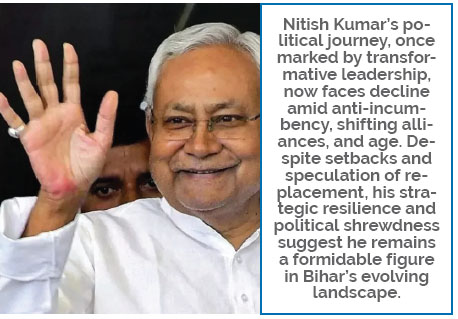 His deft political moves, banning liquor and carving extremely backwards categories (EBCs) from the existing backwards categories, endeared him to key electoral segments, especially making him a favourite among women voters. All that paid off as he managed to wrest power from the RJD, while keeping the BJP’s aggressive advances in check.
His deft political moves, banning liquor and carving extremely backwards categories (EBCs) from the existing backwards categories, endeared him to key electoral segments, especially making him a favourite among women voters. All that paid off as he managed to wrest power from the RJD, while keeping the BJP’s aggressive advances in check.
However, his constant somersaults between the BJP and the RJD have eroded his stature and painted him as an opportunist bereft of any ideology. The 2020 legislative election relegated him to a junior partner – a chota bhai – in the NDA alliance as he lost popular vote and his party managed to win only 42 seats, even as BJP’s vote and seat share jumped dramatically, reversing the equation.
Political murmurs are afoot that the BJP is planning to replace him with his own chief Minister, should they win the 2025 state polls. Some say that he may get an honourable exit, with a ceremonial post of some sort. Age, too, has caught up with him. However, the wily politician in him cannot be written off; no one who knows Nitish Kumar can dare to pen his political obituary. We, too, will err on the side of caution.
Tejaswi Yadav
He had big shoes to fill in. His father’s immense political stature and astute manoeuvring to carve out a committed vote bank in the state’s diverse polity meant that a massive change was underway as the power transition within the RJD ensued. Despite no overt competition, as is the case with family-run political enterprises, his age and political inexperience created doubts among his party leaders and cadres about his ability to lead.
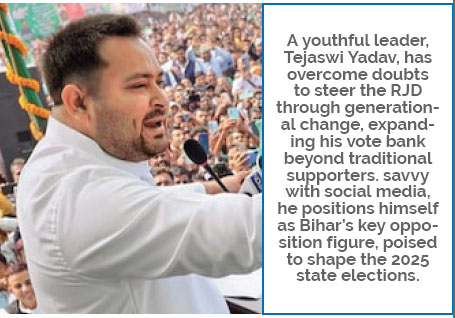 He has proven his detractors wrong, steered his party through the generational transition and pitched himself as the yuva neta (youth leader) capable of addressing the aspirations of a restless state that battles high migration, absence of employment opportunities and a non-existent industrial base.
He has proven his detractors wrong, steered his party through the generational transition and pitched himself as the yuva neta (youth leader) capable of addressing the aspirations of a restless state that battles high migration, absence of employment opportunities and a non-existent industrial base.
That his father is partly responsible for the problem is a moot point. Twenty years of NDA rule, barring a brief RJD stint, thanks to Nitish’s one of many somersaults, in 2017, has helped him position himself as the quintessential opposition leader. Also, a younger demography has almost no recollection of the Lalu-era rule, which works to his advantage. A resolute vote bank of Muslims and Yadavs continues to form a bulwark and a large chunk of his votes. Interestingly, he, too, is taking a leaf out of Akhilesh Yadav’s strategy of expanding his voter base by wooing other castes, giving them tickets to contest elections.
He has brushed aside his family troubles, seems media savvy and uses social media platforms to his advantage, posing a formidable challenge to the NDA alliance. He has also resisted Rahul Gandhi’s attempts to gain a bigger share of the ticket distribution until now, calling the shots in the INDIA alliance in Bihar. All this makes him a serious contender for the 2025 state elections.
The BJP
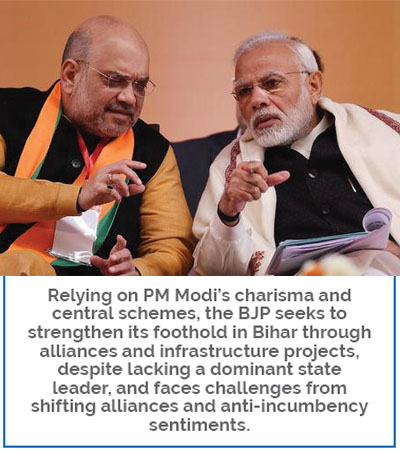 The passing away of Sushil Modi, the BJP’s longest-reigning deputy chief minister, who ably played second fiddle to Nitish Kumar, has left a void, leaving the party with no pan-state face upon which it can bank its political fortunes, even as the late Sushil Modi never really had mass appeal. Samrat Choudhary and Vijay Kumar Sinha, the two comparatively lighter weight deputy chief ministers in the present government, lack the necessary pull factor. Despite no state leader leading the charge, the BJP has done considerably well. While the BJP’s vote share has swung between 15 and 24.4%, peaking in the 2015 legislative assembly elections, caste calculus and the absence of a pan-Bihar leader have forced the BJP to play the waiting game, allowing Nitish to lead the state NDA, despite having 32 more MLAs than the JD(U) in the last assembly elections.
The passing away of Sushil Modi, the BJP’s longest-reigning deputy chief minister, who ably played second fiddle to Nitish Kumar, has left a void, leaving the party with no pan-state face upon which it can bank its political fortunes, even as the late Sushil Modi never really had mass appeal. Samrat Choudhary and Vijay Kumar Sinha, the two comparatively lighter weight deputy chief ministers in the present government, lack the necessary pull factor. Despite no state leader leading the charge, the BJP has done considerably well. While the BJP’s vote share has swung between 15 and 24.4%, peaking in the 2015 legislative assembly elections, caste calculus and the absence of a pan-Bihar leader have forced the BJP to play the waiting game, allowing Nitish to lead the state NDA, despite having 32 more MLAs than the JD(U) in the last assembly elections.
The strategy is simple. Bank on PM Narendra Modi’s massive popularity, the central government’s food scheme and a spate of infrastructure projects, including new airports and greenfield expressways, to create a favourable sentiment. The BJP has already taken the lead in attacking the RJD, reminding people of the Jungle Raj and educating young voters, indicating that it is now firmly on track to lead the coalition. However, Nitish’s mercurial tendencies, Chirag’s see-saw on many local issues, his bonhomie with Tejaswi and the anti-incumbency have made the BJP’s task more challenging.
One of the BJP’s successes has been its ability to stitch alliances, bringing smaller parties, such as Jitan Ram Manjhi’s Hindustani Awam Morcha, together to increase its voter base. Its ability to ‘manage’ Nitish, create a formidable alliance and plug in possible defections will decide its fortunes in the upcoming assembly elections.
Prashant Kishor
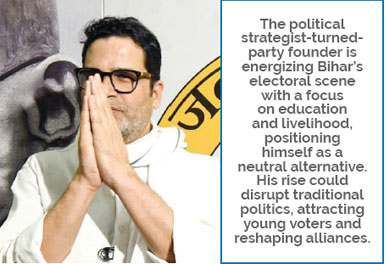 Could he be the proverbial dark horse? Could he pull a Kejriwal? The state’s political landscape is abuzz with these questions as the former poll strategist and political adviser’s newly formed party gains traction and eyeballs. What started as a social movement and a state-wide padyatras to educate the masses about the need for systemic change has snowballed into a full-fledged political movement, drawing crowds, especially young voters. His call for pronounced focus on education, livelihood and policy reforms seems to be resonating with voters’ yearning for change. The fatigue factor among voters, the novelty of a new party and a new approach to politics where education and livelihood are principal planks, subsuming caste calculus, may attract votes, catapulting him into the big league.
Could he be the proverbial dark horse? Could he pull a Kejriwal? The state’s political landscape is abuzz with these questions as the former poll strategist and political adviser’s newly formed party gains traction and eyeballs. What started as a social movement and a state-wide padyatras to educate the masses about the need for systemic change has snowballed into a full-fledged political movement, drawing crowds, especially young voters. His call for pronounced focus on education, livelihood and policy reforms seems to be resonating with voters’ yearning for change. The fatigue factor among voters, the novelty of a new party and a new approach to politics where education and livelihood are principal planks, subsuming caste calculus, may attract votes, catapulting him into the big league.
He has sharpened his attacks on Tejaswi, underlining his poor academic credentials, questioning his ability to rule the state, even firing shots at the BJP for harbouring Nitish Kumar, despite his wild swings, to position himself as the neutral third front in a state that has traditionally remained a two-front contest.
Several prominent names, including those in the media and social media influencers, have joined his party, indicating a growing momentum; however, whether this hype converts into votes remains to be seen. But Prashant Kishor’s entry has certainly spiced up an already interesting election. Will “School Bag” (his party’s political symbol) ward off “the Lantern” and dishevel “the Lotus?” It could. Time will tell!
The Congress
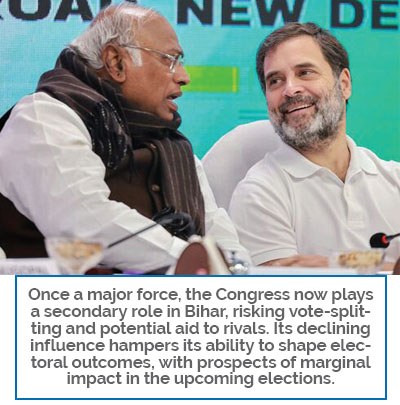 The Congress’s steady decline in Bihar, from the leading party to an also-ran, has been consistent with its pan-India story. Today, the Congress plays second fiddle to Tejaswi Yadav, who calls the shots in the INDIA alliance. While Congress’s prospects remain grim as ever, it could spoil RJD’s ambitions to rule the state. Remember the Delhi elections, where Rahul Gandhi chose to contest with full might against Kejriwal’s AAP, leading to a split in votes between the Congress and the AAP, helping the BJP romp home? Could he have a similar strategy for Tejaswi to signal to him and other INDIA alliance allies, such as Mamta Banerjee, that Congress won’t tolerate being pushed around by junior partners? These may be counter-productive for the INDIA alliance, but Rahul Gandhi’s Congress has done stranger things. How the seat sharing pans out and whether Tejaswi and Rahul find common ground will impact how the alliance shapes up, and how the election pans out for the RJD and the Congress. Not only in Bihar but across India, as other allies will be watching intently!
The Congress’s steady decline in Bihar, from the leading party to an also-ran, has been consistent with its pan-India story. Today, the Congress plays second fiddle to Tejaswi Yadav, who calls the shots in the INDIA alliance. While Congress’s prospects remain grim as ever, it could spoil RJD’s ambitions to rule the state. Remember the Delhi elections, where Rahul Gandhi chose to contest with full might against Kejriwal’s AAP, leading to a split in votes between the Congress and the AAP, helping the BJP romp home? Could he have a similar strategy for Tejaswi to signal to him and other INDIA alliance allies, such as Mamta Banerjee, that Congress won’t tolerate being pushed around by junior partners? These may be counter-productive for the INDIA alliance, but Rahul Gandhi’s Congress has done stranger things. How the seat sharing pans out and whether Tejaswi and Rahul find common ground will impact how the alliance shapes up, and how the election pans out for the RJD and the Congress. Not only in Bihar but across India, as other allies will be watching intently!
Chirag Paswan
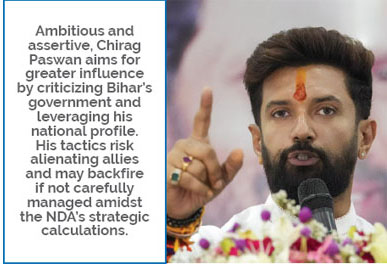 The self-professed Hanuman of PM Modi is beginning to flex his muscles, signalling his desire and intent for a bigger role in the state. Since his power tussles with his uncle, he has emerged stronger, regained control of the party’s finances and cadres, and even earned a berth in the coveted Union Ministry, suggesting that he enjoys the confidence of the BJP’s top leadership. That may change as he continues to frequently voice his opinions on administrative matters of the state, often criticising the state government, much to the chagrin of the BJP and JD(U). This may be a ploy to pressurise the BJP leadership for a more important role and more seats for his party as parties within the NDA huddle to decide the nuances of seat sharing.
The self-professed Hanuman of PM Modi is beginning to flex his muscles, signalling his desire and intent for a bigger role in the state. Since his power tussles with his uncle, he has emerged stronger, regained control of the party’s finances and cadres, and even earned a berth in the coveted Union Ministry, suggesting that he enjoys the confidence of the BJP’s top leadership. That may change as he continues to frequently voice his opinions on administrative matters of the state, often criticising the state government, much to the chagrin of the BJP and JD(U). This may be a ploy to pressurise the BJP leadership for a more important role and more seats for his party as parties within the NDA huddle to decide the nuances of seat sharing.
But political observers would know that such tactics don’t work with the BJP’s top leadership. They can be counterproductive. Pravesh Verma would know. His premature celebrations as the ‘would-be’ CM of Delhi cost him his chair! And changed the fortunes of Rekha Gupta! Chirag is playing with fire. Perhaps, he, too, has the intuition of his late father, Ram Vilas Paswan, who could sense which way the tide would turn. If not, he has more to lose than gain.
Special Intensive Revision (SIR)
The Election Commission of India (ECI) has undertaken a Special Intensive Revision of the electoral roll, which is a special audit of sorts. The sweeping and intensive revision of the electoral roll has already led to the removal of fifty-six lakh names. This omission roughly translates to 7% of the eight crore-strong electorate from the roll, ahead of elections. The Election Commission of India has said that almost twenty lakh names were deceased, twenty-six lakh had migrated permanently, over seven lakh were registered in multiple locations and over one lakh were untraceable. Which should not be surprising.
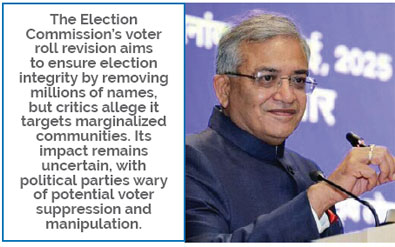 The opposition has questioned the voter-verification drive in Bihar, alleging that the BJP is trying to curtail the voting rights of marginalised communities, especially the Muslims, by using the ECI in an unconstitutional manner. The ECI has argued that such a move is critical to ensure free and fair elections, while the BJP remains unfazed and defiant. Amid the accusations and counter-accusations, the state prepares to choose the next government and with it shape national politics until 2029!
The opposition has questioned the voter-verification drive in Bihar, alleging that the BJP is trying to curtail the voting rights of marginalised communities, especially the Muslims, by using the ECI in an unconstitutional manner. The ECI has argued that such a move is critical to ensure free and fair elections, while the BJP remains unfazed and defiant. Amid the accusations and counter-accusations, the state prepares to choose the next government and with it shape national politics until 2029!
Does SIR become a player? Not necessarily enough to spoil the chances of one party or the other. But the Opposition believes these were their voters, a charge which the Opposition is meant to make. Should such a revision have been carried out? If it had not, the ECI would have been called out. If it did, then, too. Either way, the ECI becomes the fall guy in most elections, soon for the clamour to die down, and then got forgotten till the next election.
ABOUT THE AUTHOR
Shashank Shekhar is a marketing professional who writes on technology, politics, social developments and international relations. He is also a keen observer of astrophysics and space technology.








